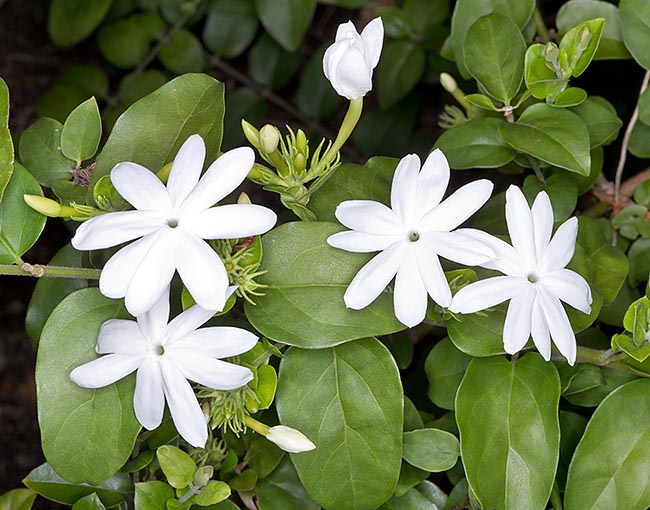Family : Oleaceae

Text © Pietro Puccio

English translation by Mario Beltramini

Jasminum multiflorum is a sarmentose reaching 3 m. Beauty, rusticity and medicinal virtues © Giuseppe Mazza
The species is native to India, Laos, Myanmar, Nepal, Thailand and Vietnam, where it grows in the forests up to about 1300 m of altitude.
The name of the genus should come from the Persian “yasmīn”; the name of the species is the combination of the Latin adjective “multus, a, um” = much, numerous and of the substantive “flos, oris” = flower, with obvious reference.
Common names: downy jasmine, hairy jasmine, star jasmine, winter jasmine (English); jasmin des haies (French); kundphul (Hindi); jasmim-da-China, jasmim-neve, giestó, jasmineiro-do-campo, jasmineiro-do-monte (Portuguese); kunda (Sanskrit); jazmín estrellado (Spanish); malulee (Thai).
The Jasminum multiflorum (Burm.f.) Andrews (1897) is an evergreen sarmentose shrub with pubescent drooping branches, up to 3 m tall and more when in presence of a support. The leaves, on a 0,5-1 cm long pubescent petiole, are opposite, simple, entire, more or less pubescent below, ovate-cordate with pointed apex, 3-8 cm long and 2-5 cm broad.
The inflorescences are dense terminal cymes on short lateral buds, carrying numerous sessile or sub-sessile flowers, with a barely perceptible scent, with basal ovate bracts, 1,5-2 cm long, calyx with 6-9 filiform lobes, about 0,6 cm long, pubescent, white funnel-shaped corolla with about 1,5 cm long tube and 7-9 oblong-lanceolate lobes with pointed apex, 1-1,5 cm long. The fruit is an ellipsoid berry black when ripe, about 1 cm long. It reproduces by seed, semi-woody cutting in summer-autumn, air and ground layering and by means of root suckers.
Vigorous species of easy cultivation and fast growth, appreciated for the copious blooming lasting for most of the year, in particular from autumn to spring, which compensates the almost absence of scent characterizing the most diffused jasmines. It is cultivable in the regions with tropical, subtropical and warm temperate climate, where it can bear temperatures of a few degrees under the 0 °C for short time, possibly with loss of the aerial part, but with re-growth in the following spring if well mulched.
Of remarkable ornamental effect, it can be utilized as isolated bush, soil cover or drooping on escarpments, for borders, hedges or leaning on fences, pergolas and grates, with regular prunings to contain the vegetation and maintain a compact habit. It prefers full sun and is not particular about the soil, but grows best on the fertile ones and well drained; the watering must be regular in absence of rains, even if it can bear, well rooted, short dry periods.
Cultivable also in pot to be sheltered in winter in the locations where the temperatures do not allow its survival in open air, in an as much as possible luminous position and where, in case, it can get some hours of sun per day, with lowest temperatures not under the 15 °C, and in such case it may even bloom; the watering must be regular in summer, spaced in winter.
In India, the flowers are offered during the Hindu religious ceremonies and are used for making garlands.
Leaves and bark are utilized since remote times in the traditional medicine; scientific studies have proved the presence of principles active in the cardiovascular sector in the leaves extracts.
Synonyms: Nyctanthes multiflora Burm.f. (1768); Nyctanthes pubescens Retz. (1788); Jasminum pubescens (Retz.) Willd. (1797); Mogorium multiflorum (Burm.f.) Lam. (1797); Mogorium pubescens (Retz.) Lam. (1797); Jasminum congestum Buch.-Ham. ex Wall. (1831); Jasminum gracillimum Hook.f (1881).
→ To appreciate the biodiversity within OLEACEAE family please click here.
